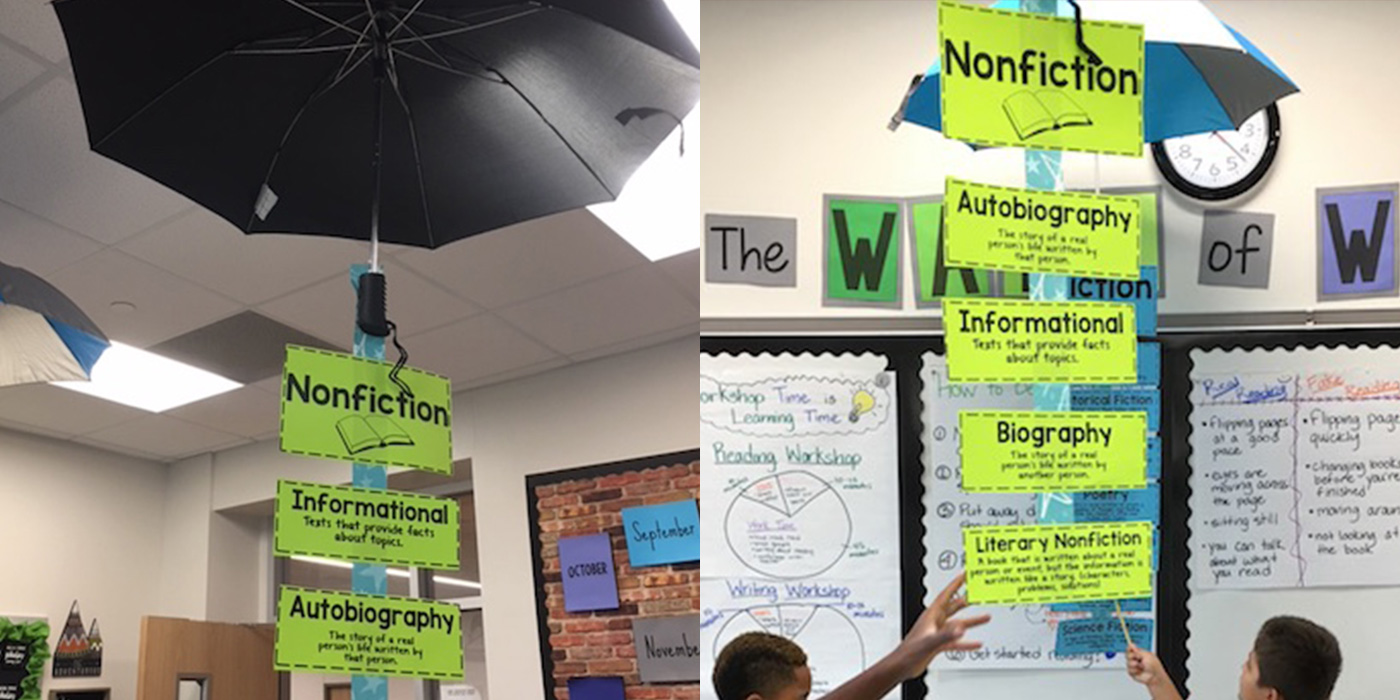Third-grade teacher Juan Gonzales loves exploring genres with his developing readers. He finds that “when the reader knows what to expect from a certain text, they are better equipped to enjoy and comprehend their reading experience.”
While most students enter 3rd grade with the ability to distinguish between fiction and nonfiction, Gonzales wanted to help his readers understand sub-genres and start building their genre vocabulary. He created and hung "genre umbrellas" for an engaging exploration lesson and class discussion on how to identify nonfiction and fiction sub-genres. Here’s how to conduct your own genre umbrella activity.
Materials
Umbrellas
Books from various genres*
Sticky notes
String
Duct tape
Ceiling hooks
Scholastic Book Clubs catalogs
Tips
Ask friends or parent volunteers to lend you umbrellas for this activity.
If your classroom library is missing books from any genres you want to feature, borrow from the school library.
If you can’t hang the umbrellas from your ceiling, simply hold them up to give students an equally compelling visual.
If you need to expand your classroom library to include more sub-genres, check out the collections below which feature books from a range of popular genres.
Setup
Prepare the activity the day before you plan to teach the lesson. Tie string to the top of the umbrellas and hang them on ceiling hooks. Use a strip of duct tape to attach the genre posters to the handle of the umbrella, with the sub-genres strung underneath their primary genres (fiction/nonfiction).
The final touch is to place a stack of books of different genres in the middle of each classroom table. When your students arrive on activity day, their eyes will sparkle with curiosity!
Task #1: Sort Books Between Fiction and Nonfiction
Introduce the lesson by acknowledging that your students already understand how to distinguish between fiction and nonfiction books, but now it’s time to dig deeper. Give a brief explanation of the sub-genres and their definitions and show book examples of each.
For the first task, students should work with their table groups to sort the books under the fiction and nonfiction umbrellas. To do this, they will need to preview the books to deduce their genres. Here are effective strategies for previewing books:
Read the title and author
Read the book blurb
Skim through a few pages
As your students work together, walk around the groups, prompting and joining in on the conversations when needed.
Task #2: Label Each Book Using Sticky Notes
After the students finish sorting, ask each group to share one book and how they decided on the correct genre umbrella. Now it’s time for the students to work together to sort each book into the umbrella sub-genres.
Once the students in each group agree on a book’s sub-genre, they should write the genre name on a sticky note and place it on the book. You can expect a lot of great discussion and many questions as their understanding of sub-genres deepens.
Task #3: Genre Book Shopping
Finally, students should share the books that were toughest to categorize. Students may struggle to distinguish between fantasy and science fiction and how they differentiate from traditional literature (fairy tales, fables, myths). Talk about these challenges and how students can use the genre definitions to guide their thinking.
The final task is a fun one — genre book shopping! Hand out the latest Scholastic Book Clubs catalog and tell your students that they will be shopping for books that fall under the different sub-genres. While browsing the catalog, students need to:
Identify the genre of each book based on the cover and mini book blurbs
Explain the elements that make the genre
Model how to complete one of the genre shopping forms and instruct students to use the hanging posters to fill out their charts as they browse their catalogs. Flipping through the catalogs is always a joy, and your students may discover a new favorite sub-genre to add to their book wish lists.
Shop more books and resources for genre discovery below! You can find all books and activities at The Teacher Store.
